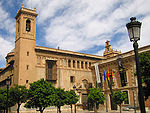González Martí National Museum of Ceramics and Decorative Arts
Art museums established in 1954Ceramics museumsDecorative arts museums in SpainMuseums in Valencia

The National Museum of Ceramics and Decorative Arts "González Martí" (Spanish: Museo Nacional de Cerámica y de las Artes Suntuarias González Martí), located in Valencia, Spain, is a museum dedicated to ceramics (with special importance to Valencian ceramics), porcelains and other decorative arts such as textile art, traditional costumes and furniture. Housed in the Palace of the Marqués de Dos Aguas, it was founded on 7 February 1947, from the donation of Manuel González Martí's ceramics collection. Seven years later, once the restoration of the palace was completed, the museum opened to the public on 18 June 1954.
Excerpt from the Wikipedia article González Martí National Museum of Ceramics and Decorative Arts (License: CC BY-SA 3.0, Authors, Images).González Martí National Museum of Ceramics and Decorative Arts
Carrer del Marqués de Dosaigües, Valencia Ciutat Vella
Geographical coordinates (GPS) Address Nearby Places Show on map
Geographical coordinates (GPS)
| Latitude | Longitude |
|---|---|
| N 39.47332 ° | E -0.37441 ° |
Address
Marqués de Dosaigües
Carrer del Marqués de Dosaigües
46002 Valencia, Ciutat Vella
Valencian Community, Spain
Open on Google Maps









